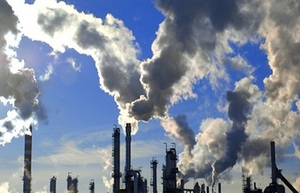Too hot to grow
Updated: 2014-06-16 07:19
By ALFRED ROMANN (China Daily)
|
|||||||||||
"Those dynamic increases (of carbon emissions) are mainly from China, so China's problem is also the world's problem."
Lin says China can be more confident on this issue now, since it has taken action to tackle smog and its
|
 |
|
 |
"The policies against the smog problem basically target the energy industry-more specifically, coal. The contribution from coal to the economy must decline annually. This is in line with the reduction of CO2 emissions.
"We have been talking about rejecting economic structure and reducing CO2 emissions for a long time, but the real economy would always choose the most cost-effective way-that is coal. It has no motive to make the change as any alternation is more expensive than coal," Lin says.
But the problem goes beyond China. Other economies are growing and their emissions are increasingly significant. Indonesia and Vietnam, for example, are increasingly industrialized.
Annie Koh, associate professor of finance at Singapore Management University, believes Asia has recognized the need to implement climate-smart growth. "Government, the private sector and civil society in Asia agree that Asia can no longer ignore the evidence pointing to how rapid growth can deplete natural capital and resources," she says.
"Governments across the region have recognized the need to have shared vision and shared responsibilities for driving change in the area of climactic catastrophes."
For Asian countries, the reality is that a coordinated approach is needed to deal with the causes of climate change, such as emissions of greenhouse gases, and the devastating natural disasters that are its effects.
"These days, the conversation is no longer about growth at all expense, but to have sustainable inclusive growth," says Koh. "ASEAN and East Asia need to ensure that we all grow as a region," she says, referring to the Association of Southeast Asian Nations.
But, says Renat Heuberger, CEO of South Pole Carbon, a social enterprise focused on environmental sustainability, Asia is also the biggest investor in the world in clean technology, which is seen as the best hope of reducing emissions.
"So in both problem and solution of climate change, Asia plays a very important role today," Heuberger says. "On one side, we see Asia exposed to climate change, especially the coastal areas. On the other side, the solution to climate change is in Asia, simply because this area is developing fast, a lot of cash is available, and it is possible to generate profit by solving climate change."
A new report by ratings agency Standard & Poor's said climate change-and global warming in particular-is the second most significant major trend likely to impact sovereign credit risk this century. And the impact is not likely to be positive. For example, Typhoon Haiyan, which hit the Philippines last year, was hugely destructive and had a direct impact on economic growth.
|
 |
 |
| China launches carbon trading in Hubei | Tianjin starts carbon trading market |
Related Stories
Climate change spurs carbon credit trading 2014-06-10 07:54
Climate change spurs carbon credit trading 2014-06-10 07:25
Officials say Madagascar victim of climate change 2014-06-06 20:08
Climate change poses dangers 2014-05-28 07:10
Climate negotiator promotes clean-burning stoves 2014-05-19 20:40
Today's Top News
49 killed as transport plane downed in Ukraine
China finds way to play in 2014 World Cup
Protocol targets sex violence
Premier all business on Europe trip
Poland-China train on maiden trip
Iraq facing 'mortal threat' from militants
China, Italy boost ties
Brazil averts strike before WCup
Hot Topics
Lunar probe , China growth forecasts, Emission rules get tougher, China seen through 'colored lens', International board,
Editor's Picks

|

|

|

|

|

|





